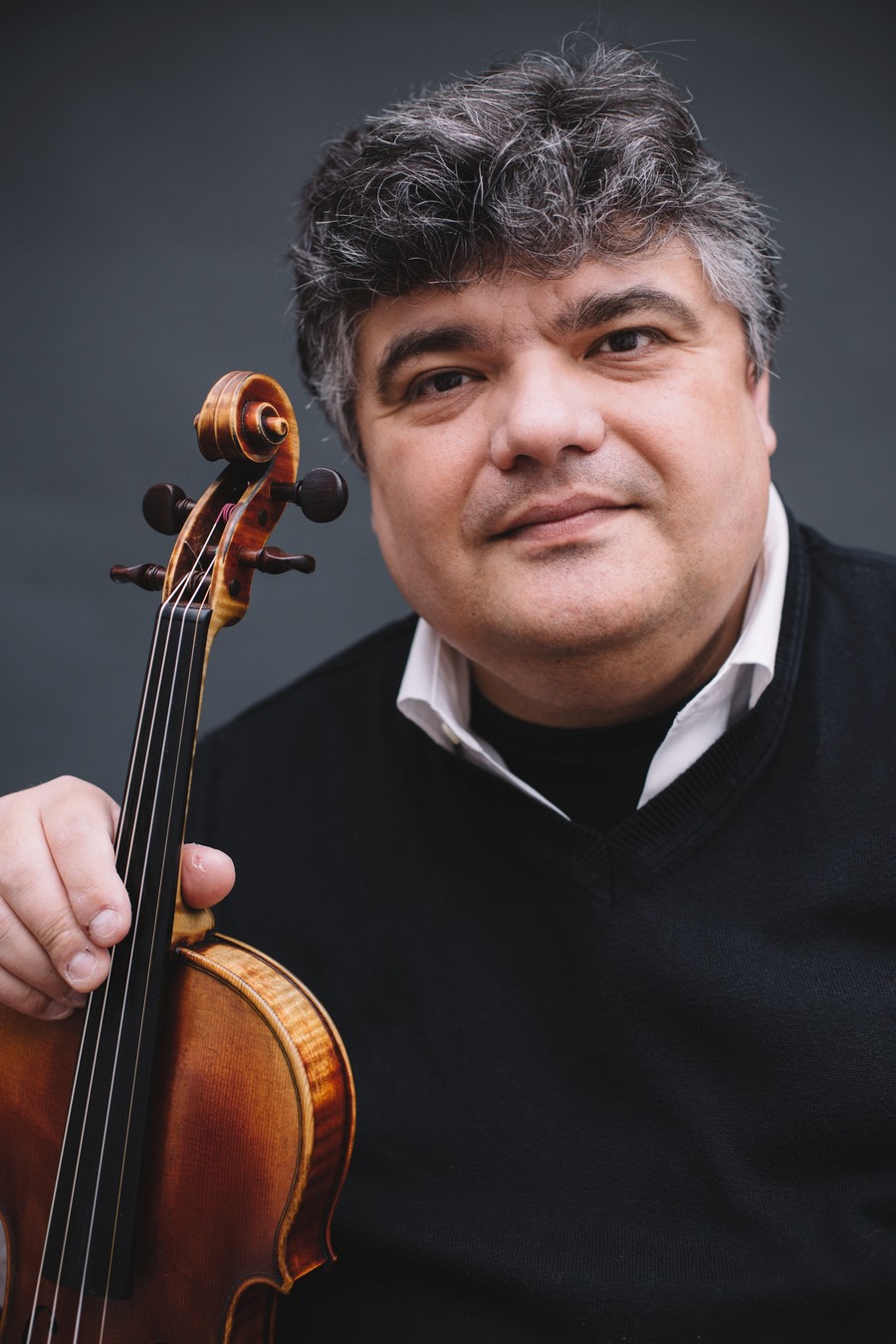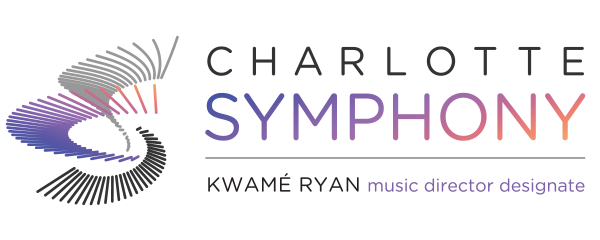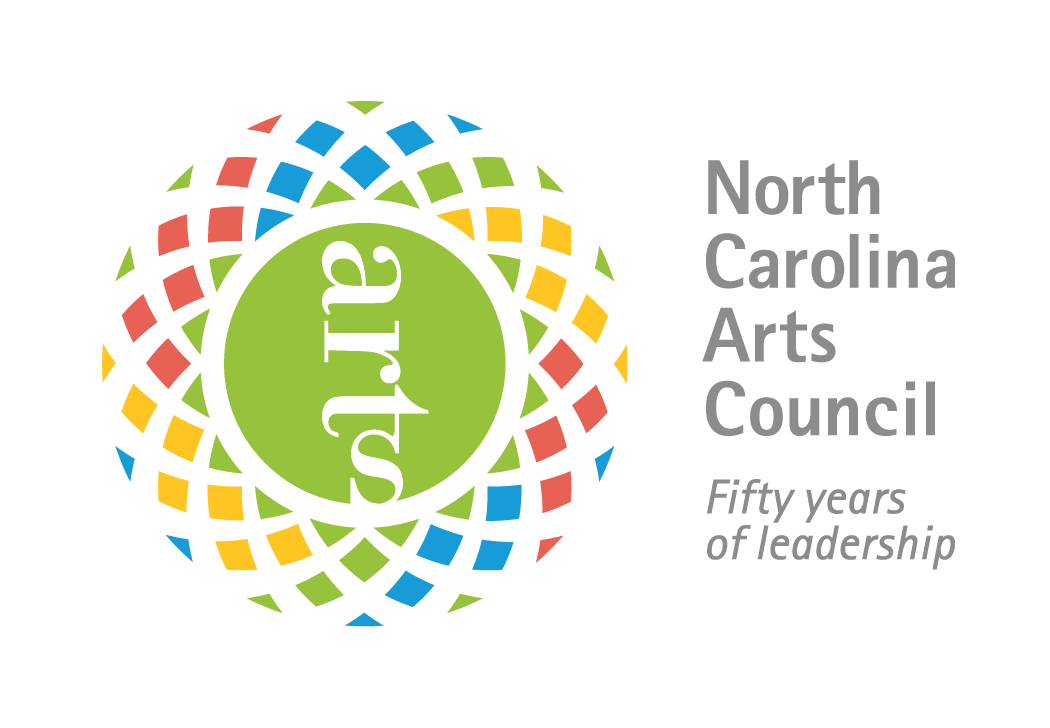December 13, 2018
 Concertmaster Calin Lupanu plays on an 1857 Pierre Silvestre violin. He traveled to many cities - at least 10 - and says he considered about 70 different instruments before coming across the one he would eventually own.
Concertmaster Calin Lupanu plays on an 1857 Pierre Silvestre violin. He traveled to many cities - at least 10 - and says he considered about 70 different instruments before coming across the one he would eventually own.
"I knew the moment that I saw it that it was a special violin," says Lupanu. "It was in mint condition and was part of a lady's estate -- she had been a professional violinist and it hadn't been played in over 30 years." He bought the violin from John Montgomery Violins in Raleigh.
Prior to his purchase of the Silvestre, Calin says he performed on a loaner instrument. And, he says, he still has his violin from Romania, where he's originally from, which he plays at outdoor venues.
But he saves the Silvestre for the mainstage. Hear Calin play on his beloved instrument when we feature him, May 17-19, 2019, as a soloist on Ravel's Tzigane. Read more
Charlotte Symphony
Charlotte Symphony
Posted in Classics. Tagged as Classical, concertmaster, Violin.
October 26, 2018
 |
Effervescent musicianship, intense lyricism and beguiling tonal beauty belong to the qualities that have secured Sergei Krylov's place among today's most renowned performers. The Russian-born violinist directs breath-taking virtuosity to reveal profound expressive insights into the works in his strikingly broad repertoire.
'Krylov articulated concisely, with humour, sometimes incisive but never defiant,' observed DiePresse.com following a recent performance of Prokofiev's First Violin Concerto. Other commentators have praised the intelligence, imagination and intuitive power of his musicianship.
In recent seasons, Sergei Krylov has become a regular guest with several major institutions and collaborated with many of the world's leading orchestras. |
He has appeared with, among others, the Dresden Staatskapelle, the St Petersburg Philharmonic, London Philharmonic and Royal Philharmonic orchestras, the Russian National Orchestra, the Mariinsky Orchestra, the Filarmonica della Scala and Accademia di Santa Cecilia, the Orchestre Philharmonique de Radio France, DSO Berlin, the Konzerthaus Orchester Berlin, Budapest Festival Orchestra, NHK Symphony Tokyo and the Atlanta Symphony Orchestra.
Among the prominent personalities with whom he has worked, Krylov's friendship with Mstislav Rostropovich stands among the most important influences on his artistic life. Over the past decade he has collaborated with many leading conductors, from Dmitri Kitayenko, Mikhail Pletnev, Valery Gergiev, Andrey Boreyko, Vasily Petrenko and Vladimir Jurowski to Fabio Luisi, Roberto Abbado, Yuri Temirkanov, Vladimir Ashkenazy, Dmitry Liss, Yuri Bashmet and Michał Nesterowicz.
Highlights of Sergei Krylov's 2017/18 season included Tchaikovsky's Violin Concerto with the London Philharmonic Orchestra and Vasily Petrenko, Prokofiev's Second Violin Concerto with the Konzerthaus Orchester Berlin and Dmitri Kitayenko, and performances with the Russian National Orchestra, Prague Radio Symphony, Copenhagen Philharmonic, Turin's Rai Orchestra, and the Orchestra of the Teatro San Carlo, Naples.
Read more
Charlotte Symphony
Charlotte Symphony
Posted in Classics. Tagged as Classical, guest artists, Violin.
September 4, 2018
If you've ever seen Joshua Bell perform live, you'll understand just how much stamina and sheer power goes into every performance. Here, we pick Joshua Bell's brain on the athleticism behind his performances.
 |
First of all, we've heard that you lose weight every time you perform?
Yes! I'm quite physical when I play, so it's quite good exercise. I probably lose at least a couple of pounds after a two-hour performance. It almost makes up for the fact that I tend to celebrate afterwards with a huge meal! Almost.
That sounds like a good workout plan. Do you exercise off-stage, too?
Well, not as much as I used to, but I still love to play tennis and basketball, and I always seem to be running through airports to catch my plane! |
You also have children you must run after quite a bit?
Yes, three. Three young boys, 8-year-old twins, and an 11 year-old. I'm trying to teach them tennis, so hopefully they will help me stay in shape.
We also hear you're a foodie.
Yes! I love food. It's one of the great joys of traveling. I love tasting foods from different regions of the world. Recent highlights were eating at Noma in Copenhagen, The French Laundry in Napa, Au Cheval in Chicago wow, what a burger! I also just got back from Asia, including Thailand, which has some of my favorite food in the world.
So what's the greatest parallel between an athlete in competition and a violinist on stage?
There are so many similarities. To excel in either, it always helps to have started young, and both require excessive training. Whether it's playing basketball or playing the violin, one must have extreme focus, and must have confidence which comes from great preparation and also from learning how to conquer ones fears and doubts under pressure - always trying to get "in the zone."
Also, as a soloist with an orchestra, you're part of a "team" effort in the presenting of music.
Absolutely. As with sports, making music is almost always a team effort. One must react to others, and know how and when to lead and when to follow. An orchestra is a lot like a football team, all with separate tasks but working toward a common goal, and the soloists job, I suppose, is to be part quarterback and part coach! (OK, maybe I've taken the analogy too far!)...It is no coincidence that I happen to love football season, and I always try my best to keep my Sundays free to watch as many games as possible! Go Panthers!
Read more
Charlotte Symphony
Charlotte Symphony
Posted in Classics. Tagged as Classical, guest artists, interview, Violin.
August 23, 2018
He was a child prodigy.
Joshua Bell was born in Bloomington, Indiana, on December 9, 1967 and began taking violin at age 4. His parents had noticed that he had stretched rubber bands across the handles of his dresser drawer to try to replay music he had heard her play on the piano. |
 |
A teenage symphonic debut.
By 14 Bell had appeared as a soloist with the Philadelphia Orchestra, conducted by Riccardo Muti. He studied violin at the Indiana University Jacobs School of Music and went on to receive an Artist Diploma in Violin Performance from Indiana University in 1989. By 17 he had debuted at Carnegie Hall debut with the St. Louis Symphony Orchestra.
A champion of new works.
Like the Charlotte Symphony, Bell is a fan of promoting new works. Having premiered Nicholas Maw's violin concerto, which is dedicated to Bell, in 1993, he won a Grammy Award for his recording. He will kick off our 2018-19 season at Opening Night, where he'll perform the Brahms Violin Concerto and we'll debut a commissioned work by Nkeiru Okoye in celebration of Charlotte at 250. |
 |
Fate and a 300-year old Stradivarius.
Bell's instrument is a storied 300-year old Stradivarius violin, the "Gibson ex Huberman," made in 1713. The instrument survived war, theft, and much more, and we'll hear it live on September 21. Read the story in Bell's own words,
here.
Oscars, etc.
Bell performed the violin solos for the Oscar-winning soundtrack for 'The Red Violin' and was also featured in film scores including 'Ladies in Lavender', 'Iris' and 'Defiance'.
A man of other talents.
On May 26, 2011, Bell was named Music Director of the British music ensemble, the Academy of St. Martin in the Fields. Selected by the orchestra members, he is the only other person to hold this position following the great Sir Neville Marriner, who founded the orchestra in 1958.
Read more
Charlotte Symphony
Charlotte Symphony
Posted in Classics. Tagged as Classical, guest artists, Violin.
July 25, 2018
The Huberman Violin
by Joshua Bell, on his historic instrument's 300th birthday.
My violin is over 300 years old.
Known as the Gibson ex Huberman, the revered instrument came into my life one fateful day during the summer of 2001. I was in London, getting ready to play a Proms concert at the Royal Albert Hall and decided to stop by the famous violin shop, J & A Beare to pick up some strings. As I entered the shop, Charles Beare was just coming out of the back room with a stunning violin in hand. He told me that it was the famous Huberman Strad, and of course I was instantly intrigued.

I soon learned all of the known details of the violin's remarkable history, which is complete with twists and turns to rival the film that I had only recently finished working on,
The Red Violin. Believed to be one of only five or six instruments made in 1713 by Antonio Stradivari in Cremona, Italy, the violin has belonged to many, including the English violinist George Alfred Gibson. But it was its connection to Bronislaw Huberman that I found particularly fascinating and somewhat personal.
Huberman was a Jewish Polish violinist who lived from 1882-1947. He was a child prodigy who was revered for his remarkable virtuosity and daring interpretations. Huberman studied under Joseph Joachim in Berlin, and by the age of 11 he was already touring Europe as a virtuoso. It was during one of those early tours that he met the pianist Arthur Rubinstein, who was only six at the time, and had not yet achieved the legendary status that he came to hold. The two musicians remained lifelong friends.
At 13 Huberman had the honor of performing the violin concerto of Johannes Brahms in the presence of the composer himself, who was stunned by his interpretation. According to biographer Max Kalbeck, "As soon as Brahms heard the sound of the violin, he pricked up his ears, during the Andante he wiped his eyes, and after the Finale he went into the green room, embraced the young fellow, and stroked his cheeks. When Huberman complained that the public applauded after the cadenza, breaking into the lovely Cantilena, Brahms replied, 'You should not have played the cadenza so beautifully.' "
Huberman became one of the most celebrated musicians of his time, but it was in 1929 that his contribution to humanity took on an added dimension. During that year he visited Palestine and came up with the idea to establish a classical music presence there. During Hitler's rise to power, Huberman had the foresight to realize he could save many Jewish artists while fulfilling his desire to start a Palestinian Orchestra. Huberman auditioned musicians from all over Europe. Those selected for the orchestra would receive contracts and, most importantly, otherwise impossible-to-get exit visas from their homeland to Palestine. Huberman raised the money for the musicians and then their families, even partnering with Albert Einstein to set up an exhaustive U.S. fundraising trip in 1936. By the end of that tour, the money for the orchestra was secured and sixty top-rate players had been chosen from Germany and Central Europe.
All in all, it was a fantastically successful tour, barring one particular performance at Carnegie Hall on February 28th. That night Huberman chose to play the second half of his concert on his 'other violin', a Guarneri del Gesu. During the applause following his performance of the Franck Sonata, Huberman's valet walked on stage to inform him that his Stradivarius had been stolen from his dressing room. The police were called while Huberman tried not to panic, continuing optimistically with his encores. The instrument had previously been stolen in 1919 from a hotel room in Vienna but was recovered days later when the thief tried to sell it. This time, Huberman was not so lucky.
There are several versions as to exactly how and why the violin was stolen, but what we know for sure is that the instrument ended up in the hands of a young freelance violinist by the name of Julian Altman. Some say Altman's mother convinced him to steal it; others report that Altman bought if off the actual thief for $100. Regardless, Altman took great pains to conceal the violin's true identity, covering its lovely varnish with shoe polish and performing on it throughout the rest of his career, which included a stint as first chair with the National Symphony Orchestra during World War II.
Heartbroken, Huberman never saw his Stradivarius again. However, his great dream was fulfilled when the new Palestine Orchestra made its debut in December of 1936 with the great Toscanini on the podium. I like to imagine that my own relatives might have been in the audience on that opening night, as my grandfather was born there and my great grandfather was part of the first "Aliyah" of Russian Jewish immigrants to Palestine in 1882. As for his violin, it was played by its suspected thief for over fifty years, and in 1985, Julian Altman made a deathbed confession to his wife, Marcelle Hall, about the true identity of the instrument. She eventually returned the violin to Lloyd's of London and received a finder's fee; and the instrument underwent a nine month restoration by J & A Beare Ltd which noted it was like "taking dirt off the ceiling of the Sistine Chapel."
The instrument was then sold to the late British violinist Norbert Brainin of the Amadeus String Quartet. Previous to my fortuitous encounter with the violin at J & A Beare, Brainin had once let me play it after a rehearsal of the Mozart g minor string quintet which I had the pleasure of playing with him one evening in the 1990s. "One day you might be lucky enough to have such a violin," he had said prophetically.
And so here I was in 2001, buying some strings at the violin shop and I was introduced to the 1713 Stradivarius again. As it was handed to me, I was told it was being sold to a wealthy German industrialist for his private collection. However, after playing only a few notes on it I vowed that this would not happen. This was an instrument meant to be played, not just admired. I fell in love with the instrument right away, and even performed that very night on it at the Royal Albert Hall. I simply did not want it to leave my hands.
This violin is special in so many ways. It is overwhelming to think of how many amazing people have held it and heard it. When I perform in Israel with the Israel Philharmonic, I am always touched to think how many of the orchestra and audience members are direct descendants of the musicians Huberman saved from the Holocaust with funds raised by concerts performed on the very same instrument I play every day. Who knows what other adventures will come to my precious violin in the years to come? While it certainly will be enjoyed and admired long after I am not around anymore, for the time being I count myself incredibly lucky to be its caretaker on its 300th birthday.
Read more
Charlotte Symphony
Charlotte Symphony
Posted in Classics. Tagged as Classical, guest artists, Violin.
December 12, 2017
| Hailed as "a fearsomely powerful musician" by The Toronto Star, Canadian-born violinist Aisslinn Nosky is one of the most versatile and dynamic violinists today. She is in demand internationally as a soloist and director and was appointed Concertmaster of the Handel and Haydn Society in 2011. She has performed in solo and chamber music recitals across North America, Europe and Asia. |
 |
Recent appearances as soloist include La Jolla SummerFest, the Staunton Music Festival, the Thunder Bay Symphony, Holland Baroque, the Calgary Philharmonic, and Tafelmusik Baroque Orchestra. In 2016 Aisslinn was named Principal Guest Conductor of the Niagara Symphony.
As a founding member of the Eybler quartet, Nosky explores repertoire from early quartet literature on period instruments. The Eybler Quartet's recording of Haydn's Opus 33 string quartets was released in 2012 on the Analekta label.
The Globe and Mail mused "Many a great string quartet annihilates Haydn with incorrect tempos, intense legato, and a general misunderstanding of classical syntax. Here we have them as the composer might have heard them himself. In fact, maybe even better."
As Co-Artistic Director of I FURIOSI Baroque Ensemble, Aisslinn has helped bring an enthusiastic new audience to baroque music. Since 2001, I FURIOSI has presented its own flamboyant and inventive concert series in Toronto, and they have toured North America and Europe.
Aisslinn began playing violin at age three and received her early training at the Nanaimo Conservatory with Heilwig von Konigslow. At age eight, Aisslinn made her solo debut with the CBC Vancouver Orchestra. When she was 15, Nosky began studying in Toronto with Lorand Fenyves, at the Royal Conservatory of Music's Glenn Gould School. Further studies included both solo and chamber music for several summers at the Banff Centre for the Arts, and chamber music at the Steans Music Institute of the Ravinia Festival as a member of the Metro String Quartet.
Read more
Charlotte Symphony
Charlotte Symphony
Posted in Classics. Tagged as Classical, conductors, guest artists, Violin.
October 30, 2017
Born in 1989, American violinist Benjamin Beilman is winning plaudits across the globe for his compelling and impassioned performances, his deep rich tone and searing lyricism and is quickly establishing himself as one of the most significant artists of his generation. The New York Times has praised his "handsome technique, burnished sound, and quiet confidence [which] showed why he has come so far so fast". Reviewing his latest recording, The Strad said "Beilman imbues every idea with a scorching expressive imperativeness... soaring aloft with ear-ringingly pure intonation... then lacerating our sensitivities with hectoring explosions of sound."
In Europe Beilman has performed with many of the major orchestras including the London Philharmonic, Frankfurt Radio Symphony and Zurich Tonhalle and in 16/17 made his debut with the Rotterdam Philharmonic, City of Birmingham Symphony orchestras and the Orchestre National de Capitole de Toulouse. In the US recent highlights have included a return San Francisco Symphony, and debuts with Dallas Symphony, Atlanta Symphony and Nashville Symphony orchestras.
Beilman performs regularly in recital and chamber music, appearing at halls such as Wigmore Hall, Stockholm Concert Hall, Louvre (Paris), Rudolfinum (Prague), Philharmonie (Berlin) and at festivals including Verbier, Aix-en-Provence Easter, Colmar, Moritzburg, Heidelberg and in 2017 he made his debut at Amsterdam's Concertgebouw in the Robeco Summer Concerts in trio with Louis Schwizgebel and Narek Hakhnazaryan. In the US Beilman performs regularly at Carnegie Hall and is a frequent guest artist at festivals such as Music@Menlo, Marlboro, Seattle Chamber Music; further afield he made a ten-city recital tour of Australia in 2016 with Andrew Tyson and looks forward to recitals in SE Asia in the coming seasons.
Beilman has received several prestigious awards including a Borletti-Buitoni Trust Fellowship, an Avery Fisher Career Grant and a London Music Masters Award. In 2010 he won the First Prize in the Young Concert Artists International Auditions, and as First Prize Winner of the 2010 Montréal International Musical Competition and winner of the People's Choice Award, Beilman recorded Prokofiev's complete sonatas for violin on the Analekta label in 2011. In 2016 he released his first disc for Warner Classics titled Spectrum, featuring works by Stravinsky, Janacek and Schubert.
Beilman studied with Almita and Roland Vamos at the Music Institute of Chicago, Ida Kavafian and Pamela Frank at the Curtis Institute of Music, and Christian Tetzlaff at the Kronberg Academy. He plays the "Engleman" Stradivarius from 1709 generously on loan from the Nippon Music Foundation.
Read more
Charlotte Symphony
Charlotte Symphony
Posted in Classics. Tagged as Classical, guest artists, Violin.
March 19, 2015
What exactly goes into the role of concertmaster? Here, we pick Concertmaster Calin Lupanu's brain about the job.
What exactly is the job?
The Concertmaster is the first violinist seated to the conductor's left. He or she is the leader of the first violin section, the string section, and the entire ensemble. In some instances the concertmaster serves as the conductor's assistant. The concertmaster must be an excellent violinist and musician, but also a very good diplomat, able to help with the conductor's interpretation of the musical score.
What else is different about what you do versus the other violinists?
By setting the standards, through a professional attitude, and very thorough preparation, a concertmaster is also a spokesman of the orchestra. |
 |
Are your hands insured, like a basketball player or a surgeon?
No, but judging by the amount of times that I get this question, maybe I should think about it!
What's your favorite part of the job?
Just really loving what I am doing. I love being part of an orchestra.
What's the hardest part of the job?
Sometimes I'm so busy that I can't spend enough time with my family or friends.
Well, I'm sure a lot of people can relate to that, but you have to learn a lot of music quickly and work with touring Pops groups and guest conductors, etc. How do you adapt?
I am able to adapt to any conductor pretty quickly. I think that one never stops learning, and that is what guides me in my career.
What if you disagree with their interpretations of a piece?
It's not my job to agree or disagree with any interpretation or with any conductor. I am more of an enabler I help the conductor submit his or her vision of a work. Having said that, I do have strong feelings about how a piece of music should be played ... but I save those feelings for when I play a solo or to some extent in chamber music performances.
What does a typical non-rehearsal/non-performance day entail for you?
There are very few of those! But I do teach a lot. I am currently on the faculty at both Gardner-Webb University and University of North Carolina at Greensboro. I also love chamber music, and I try to perform a lot of quartets, quintets, piano trios ... I have also been appointed as Chamber Music Director of the Colorado Music Festival, so I have to do programming and choose the personnel for those concerts. When I do have the occasional day off, I tend to stay with my family and maybe watch a soccer game with my 7 year old.
Charlotte Symphony
Charlotte Symphony
Posted in Classics. Tagged as Classical, concertmaster, CSO Musicians, interview, Musicians, Violin.
November 19, 2014
| Originally from Timisoara, Romania, Concertmaster Calin Lupanu moved to Charlotte in the fall of 2003, when he won the Charlotte Symphony job. Here, he talks about his hometown, his 10-city search for the perfect violin, and how he gets in the zone before a performance. |
 |
How were you introduced to the violin?
I didn't have much of a choice. My mom was Principal Harp at the Bucharest Philharmonic and my grandfather was the Music Director of the Opera House in Cluj.
Is there an interesting story behind your instrument?
My violin is a Silvestre, 1857. I purchased it about 6 years ago. I did travel to about 10 major cities in the U.S. to see violins, and I saw 79 violins before I got to see this one.
Tell us a little bit about your hometown of Timisoara, Romania.
Timisoara is a beautiful city, architecture inspired by the Austro-Hungarian and the House of Habsburg. German and Hungarian communities are very prominent. Its nickname is "the Garden City" because of the numerous parks and gardens. River Bega runs through its downtown.
What goes through your head just before each performance?
Before the performance begins I am trying to focus and get into a musical "zone," if that makes any sense. I am trying to visualize the stage, the audience, and get in the right mood. We performers have one chance to get it right. We don't have a "delete" or "backspace" button that can redo any passages. A live performance is nothing like a recording. A recording usually has lots of takes, even the Live recordings. That creates a lot of mental pressure and you need to be able to stay focused for long periods of time. I have been dealing with this kind of pressure my entire musical life, from international competitions, to performances and tours, and playing for some of the greatest musicians, especially in the chamber music world.
What would surprise audiences about your role as Concertmaster?
Everyone knows that a Concertmaster has to be a strong player and a good musician, but what would surprise people is the endurance required to play a major solo one day, a violin concerto the next day and a chamber music concert after all that. That is something that comes with experience, and they don't teach you in school how tough it is. Pacing yourself is paramount so you can always sound fresh.
What would you do if you weren't a professional musician?
I only know music, and I can't imagine myself doing something else.
What music do you listen to when you're not performing or rehearsing?
I listen to a lot of music, different genres, from Classical to Rock, Jazz, etc. The music on my iPod is a melting pot.
What is something you can't live without?
I can't live without my family: my wife and my almost-7-year-old boy. At some point, I will have to learn to live without my violin, but I don't think that I could learn to live without my family.
Tagged as concertmaster, CSO Musicians, interview, Musicians, Violin.


 Concertmaster Calin Lupanu plays on an 1857 Pierre Silvestre violin. He traveled to many cities - at least 10 - and says he considered about 70 different instruments before coming across the one he would eventually own.
Concertmaster Calin Lupanu plays on an 1857 Pierre Silvestre violin. He traveled to many cities - at least 10 - and says he considered about 70 different instruments before coming across the one he would eventually own.












